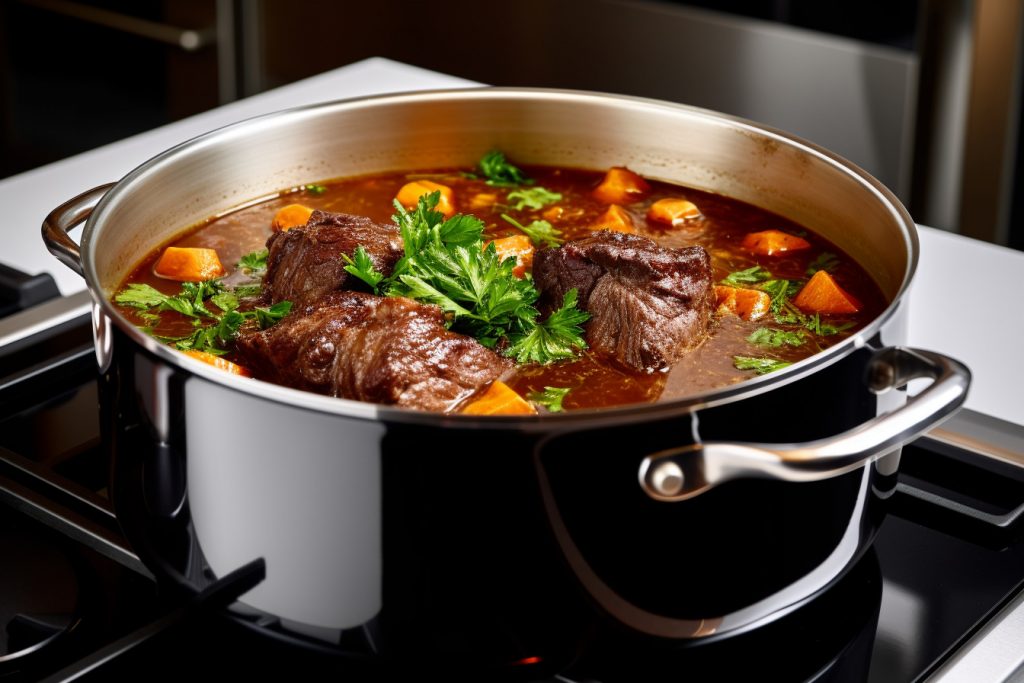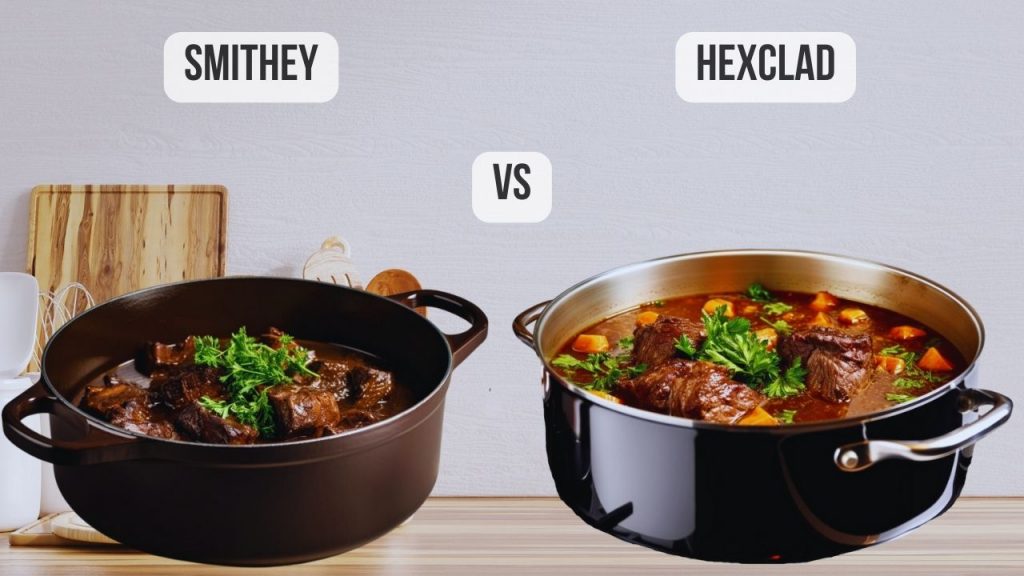As a seasoned restaurant chef with over a decade of experience in the culinary industry, I understand the importance of choosing the right tools for the kitchen. In this article, we’ll embark on a detailed comparison between two popular Dutch ovens: the HexClad Dutch Oven and the Smithey Dutch Oven. I’ll evaluate these products based on ten essential factors that are crucial for any cook looking to make an informed decision. These factors include:
- Material
- Weight
- Heat retention and compatibility
- Lid fit
- Handles and product design
- Colors
- Maintenance and cleaning
- Durability and performance
- Warranty
- Price
Among the best Dutch ovens on the market today, Smithey stands out in the TOP-5.
Join me as we delve into the specifics of these Dutch ovens and conduct a cooking test to see how they stack up against each other in a practical kitchen setting.
In this review, I provide an independent assessment of the pros and cons of Smithey and the HexClad, based on my experience as a chef. If you choose to purchase it, please consider using the referral links included in this article. I earn a small commission from your purchases at no additional cost to you, which helps support this blog. Thank you!
Smithey VS HexClad: Material
| Smithey | HexClad |
|---|---|
| Smithey Dutch Ovens are crafted from high-quality cast iron. They are hand-finished with a polished interior and a matte enameled exterior. Hence, it gives them a sleek and premium appearance. | The HexClad Dutch Oven stands out with its stainless steel make and innovative hexagonal non-stick surface. It’s safe, free from toxins and PFOA, and utilizes a combination of ceramic, diamond dust, and stainless steel for optimal performance. |
Smithey VS HexClad: Weight
| Smithey | HexClad |
|---|---|
| Because of its high-quality construction, Smithey Dutch Ovens are known for their heft. While the material used proves its durability, it can be a drawback for some people who are not used to heavy cookware. | HexClad is lightweight due to its stainless steel construction. |
Smithey VS HexClad: Heat Retention and Compatibility
| Smithey | HexClad |
|---|---|
| The Smithey Dutch Oven excels in heat retention, making it ideal for precise temperature control during cooking. Its cast iron body retains heat exceptionally well, which is crucial for recipes like braised short ribs, where a steady simmer is needed to tenderize the meat and enhance flavors. The Dutch oven’s compatibility with various heat sources, including stovetops, ovens, and open flames, allows for a seamless transition from searing to slow braising. | The HexClad Dutch oven excels in heat retention. Its tri-ply design, incorporating an aluminum layer between two stainless steel layers, ensures exceptional heat distribution, resulting in consistent cooking temperatures. This Dutch oven’s heat compatibility is also impressive. It can be used on gas, electric, and induction stovetops and in ovens up to 500 degrees Fahrenheit. |
Smithey VS HexClad: Lid Fit
| Smithey | HexClad |
|---|---|
| The Smithey Dutch Oven comes with a well-fitting lid that helps to trap moisture and heat effectively, ensuring your dishes come out perfectly cooked. It has self-basting spikes under the lid to ensure even moisture and flavor distribution, improving the taste and texture of dishes. | The HexClad Dutch oven‘s lid provides a snug fit, effectively sealing moisture and flavors while braising. |
Smithey VS HexClad: Handles and Product Design
| Smithey | HexClad |
|---|---|
| The handles of the Dutch oven are thoughtfully crafted, offering a comfortable hold and effortless control. The handles’ ergonomic design makes it easy to lift and maneuver even when carrying a heavy pot filled with food. The Dutch oven’s elegant appearance combines classic allure with modern sophistication. Smithey Dutch ovens truly serve as authentic, eye-catching centerpieces in any kitchen. | The handles of HexClad are practical and ergonomic. I can firmly grasp the pot even when using oven mitts. This Dutch oven has a clean and classic style that will complement any kitchen. |
Smithey VS HexClad: Colors
| Smithey | HexClad |
|---|---|
| Smithey offers a limited color range. It has an enameled exterior, typically featuring a classic black finish. | HexClad is exclusively offered in its signature stainless steel design with a round shape in a 5-quart size. |
Smithey VS HexClad: Maintenance and Cleaning
| Smithey | HexClad |
|---|---|
| While cast iron requires a tad more maintenance than nonstick alternatives, the Smithey Dutch Oven‘s smooth interior enamel makes cleaning a relatively straightforward task. I only need to soak it briefly and scrub it gently with a non-abrasive sponge to remove cooking residues. It’s essential to ensure thorough drying and apply a light oil coating to prevent rust to maintain its optimal condition. | HexClad has a non-stick surface, making cleaning effortless with a simple wipe or gentle scrub. However, it’s essential to consider that the long-term durability of this non-stick coating may not meet some users’ expectations. |
Smithey VS HexClad: Durability and Performance
| Smithey | HexClad |
|---|---|
| Smithey undeniably upholds its dedication to durability, meticulously crafting this Dutch oven with top-tier materials. The Dutch oven’s remarkable performance makes it a wise long-term investment. By giving proper care and maintenance, this Dutch oven can endure for many years and become a cherished heirloom passed down to the next generation. | The HexClad Dutch Oven offers outstanding cooking performance, delivering tender and flavorful results with various dishes, including short ribs, soups, stews, and searing meats. However, I think it may not match the longevity of cast iron Dutch ovens. |
Smithey VS HexClad: Warranty
| Smithey | HexClad |
|---|---|
| Smithey offers a limited lifetime warranty on their Dutch Ovens. This warranty reflects the company’s confidence in the product’s durability. | HexClad provides a limited lifetime warranty similar to other leading Dutch oven brands. |
Smithey VS HexClad: Price
| Smithey | HexClad |
|---|---|
| Smithey Dutch Ovens are on the higher end of the price spectrum, justifying the investment with premium materials and craftsmanship. | HexClad costs more than the Smithey Dutch oven, mainly due to its patented technology. |
Cooking Test

I conducted a cooking test between the Smithey and HexClad Dutch Ovens to examine their performance based on three key parameters.
Browning

Both the Smithey Dutch Oven and HexClad Dutch Oven have excellent browning capabilities. Their superior heat retention and even distribution create a perfect environment for achieving a deep and flavorful sear on meats and other ingredients.
Moisture Retention
The Smithey Dutch Oven is renowned for its ability to maintain a consistent simmer. It ensured that the short ribs remained juicy and tender. The braising liquid clung to the meat, resulting in a perfectly moist final dish.
While HexClad does a good job at moisture retention, it might not be as effective as Smithey. However, it maintains a satisfactory level of moisture in dishes.
Final Flavor

In the Smithey Dutch Oven, precise temperature control allowed the flavors to meld harmoniously. The short ribs developed a remarkable depth of flavor, their taste rich and satisfying.
On the other hand, the HexClad Dutch Oven, with its stainless steel and non-stick surface, may not infuse the same depth of flavor as cast iron, but it still preserves and enhances the taste of the dishes.
How We Tested
In order to fairly and comprehensively assess the performance of the Smithey and HexClad Dutch Ovens, we adopted a structured test procedure, covering various cooking aspects.
Our first step was to examine their ability to brown food. We seared different types of meat and ingredients in each Dutch oven, observing their capacity to produce a uniform and rich crust. For a balanced comparison, we maintained identical cooking times and temperatures.
We then shifted our focus to how effectively each Dutch oven maintained moisture during cooking. By tracking and contrasting the moisture levels, we gauged each pot’s capability in moisture conservation.
Finally, to determine the influence on the overall taste of the meals, we prepared the same recipes in both Dutch ovens. We sampled and contrasted the dishes from each, noting any variations in flavor intensity and quality.
Conclusion: Smithey is The Winner
Concluding our comprehensive comparison of the Smithey and HexClad Dutch Ovens, it’s clear that each has its unique strengths and suits different cooking needs. However, based on the key factors we’ve analyzed – including material, weight, heat retention and compatibility, lid fit, handles and product design, colors, maintenance and cleaning, durability and performance, warranty, and price – the Smithey Dutch Oven emerges as the winner in this culinary showdown.
The Smithey excels notably in the cooking test, showcasing superior browning abilities, exceptional moisture retention, and an impressive capacity to enhance and deepen the flavors of dishes. Its cast iron construction and thoughtful design elements contribute to a cooking experience that is not just about efficiency, but also about the art of cooking. The Smithey Dutch Oven’s performance in our test kitchen, particularly in terms of maintaining a consistent simmer and ensuring a moist and flavor-rich outcome, sets it apart.
However, if you are looking for an affordable Dutch oven for home cooking, then, Smithey might be a good option for you. If you decide to purchase it, please use my referral link.
Don’t forget to check out the top Dutch ovens hand-picked by chef Bradley Thompson.

